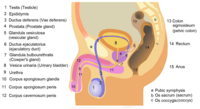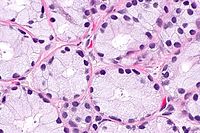
Back Glandula de Cowper AN غدة بصلية إحليلية Arabic Булбо-уретрална жлеза Bulgarian বাল্বৌরথ্রাল গ্রন্থি Bengali/Bangla Bulboureterska žlijezda BS Glàndules bulbouretrals Catalan لووی کۆپەر CKB Cowperova žláza Czech Chwarren bwlbwrethral Welsh Cowpers kirtel Danish
| Bulbourethral gland | |
|---|---|
 Male anatomy | |
 Micrograph of bulbourethral gland. H&E stain. | |
| Details | |
| Precursor | Urogenital sinus |
| System | Male reproductive system |
| Artery | Artery of the urethral bulb |
| Identifiers | |
| Latin | glandula bulbourethralis |
| MeSH | D002030 |
| TA98 | A09.3.09.001 |
| TA2 | 3659 |
| Anatomical terminology | |
The bulbourethral glands or Cowper's glands (named for English anatomist William Cowper) are two small exocrine and accessory glands in the reproductive system of many male mammals.[1] They are homologous to Bartholin's glands in females. The bulbourethral glands are responsible for producing a pre-ejaculate fluid called Cowper's fluid (known colloquially as pre-cum), which is secreted during sexual arousal, neutralizing the acidity of the urethra in preparation for the passage of sperm cells.[2] The paired glands are found adjacent to the urethra just below the prostate, seen best by screening (medicine) MRI as a tool in preventative healthcare in males. Screening MRI may be performed when there is a positive prostate-specific antigen on basic laboratory tests. Prostate cancer is the second-most common cause of cancer-related mortality in males in the USA.
Most species of placental mammals have bulbourethral glands, but they are absent in whales, dolphins, and porpoises. They are the only accessory reproductive glands in male monotremes. Placental mammals usually have 1 pair of bulbourethral glands,[3] while male marsupials have 1–3 pairs.[3][4][5] Of all domesticated animals, they are absent only in dogs.[6]
- ^ Liebich, Hans-Georg (2019-10-31). Veterinary Histology of Domestic Mammals and Birds 5th Edition: Textbook and Colour Atlas. 5m Books Ltd. ISBN 978-1-78918-106-7.
- ^ "What is pre-ejaculatory fluid (also known as pre-cum), and can it cause pregnancy?". International Planned Parenthood Federation. 13 February 2019. Retrieved 21 July 2019.
- ^ a b Dixson, Alan F. (2021-06-03). Mammalian Sexuality: The Act of Mating and the Evolution of Reproduction. Cambridge University Press. ISBN 978-1-108-69949-5.
- ^ Armati, Patricia J.; Dickman, Chris R.; Hume, Ian D. (2006-08-17). Marsupials. Cambridge University Press. ISBN 978-1-139-45742-2.
- ^ Tyndale-Biscoe, C. Hugh; Renfree, Marilyn (1987-01-30). Reproductive Physiology of Marsupials. Cambridge University Press. ISBN 978-0-521-33792-2.
- ^ Mark McEntee (December 2, 2012). Reproductive Pathology of Domestic Mammals. Elsevier Science. p. 333. ISBN 978-0-323-13804-8. Retrieved August 20, 2013.
© MMXXIII Rich X Search. We shall prevail. All rights reserved. Rich X Search